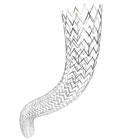|
Peripheral artery disease affects millions of Americans. People with PAD may experience lifestyle-limiting symptoms, such as leg pain, or serious complications, including skin ulcers or gangrene. Existing options for treatment of PAD can include exercise, drug therapy, and other options within the artery, such as percutaneous transluminal angioplasty (PTA, or balloon angioplasty), or bare-metal stenting or surgical bypass. In a press release Christy Foreman, director of the Office of Device Evaluation at FDA's Center for Devices and Radiological Health, stated:
The key clinical trials on which the approval was based compared the safety and effectiveness of the Zilver PTX stent to PTA and bare-metal stenting. One study enrolled 479 patients with a single blockage less than 140 mm long in one or both femoropopliteal arteries. Patients were randomized to receiving the Zilver PTX or balloon angioplasty (PTA). If PTA failed, the patient received either a Zilver PTX or a bare metal stent. At one year, 83% of narrowings treated with the Zilver were still open, compared with 33% in the PTA control group. Among patients who failed the PTA treatment, 90% of narrowings treated with the Zilver PTX were open at 12 months compared with 73% for those treated with the bare metal stent. In a separate study, researchers enrolled 787 patients in a 12-month clinical trial where patients could receive up to four Zilver PTX stents for treating a single or multiple lesions. Researchers detected stent fractures in 1.54% of Zilver PTX stents at 12 months. The stent fractures did not result in any detectable clinical consequences. The rate of stent thrombosis was 2.8% at 12 months and 3.5% at 24 months. The FDA stated that "the study results indicated that treatment with the Zilver PTX stent was at least as safe as treatment with PTA and significantly more effective. In both studies, the most common major adverse event was restenosis requiring additional treatment to re-establish adequate flow in the artery." As part of the approval, the FDA is requiring the manufacturer to conduct a five-year post-approval study of 900 patients treated with the Zilver-PTX Stent to further monitor safety and efficacy. This advance is but the mst recent development in the treatment of PAD. On the horizon are more clinical studies with new devices, such as drug-eluting balloons, and more advanced atherectomy devices. For a perspective on the history of the treatment of peripheral artery disease, see our Editor's Blog post, "Angioplasty: From the Legs to the Heart and Back to the Legs." Reported by Burt Cohen, November 15, 2012 |

